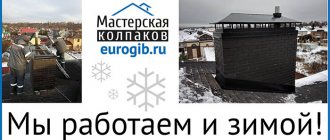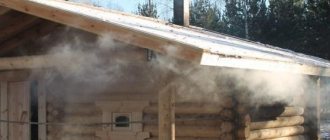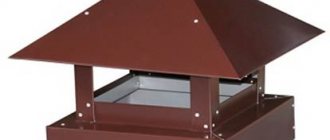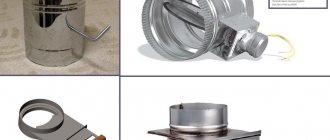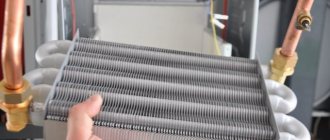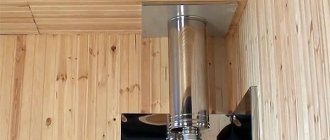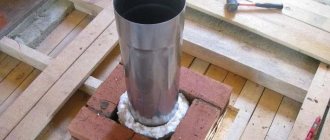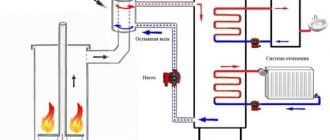A mixture of gases with fuel combustion products from fireplaces, stoves and heating boilers exits through the chimney into the street. Looking at private houses, you will notice that the head of the pipe is crowned with a special canopy or umbrella. At first glance at these devices, decorated with figured forging, intricate patterns and figures, one gets the impression that they are just a decorative element. In fact, the chimney cap is an important element of the smoke removal system, the correct design and installation of which affects the efficiency of its operation. This article will tell you about the principles of operation, types and methods of making deflectors yourself.
Choice of shape and material
The chimney cap was invented quite a long time ago . It solves several practical problems:
- protects the chimney from external factors: rain, snow and wind;
- acts as an additional roof decoration.
It is important to provide, first of all, protection from wind and precipitation, otherwise the walls of the chimney will be destroyed under the influence of weather conditions.
The cover should be selected in accordance with:
- channel type;
- hole diameter.
Based on these indicators, select:
- a cap made of chrome and nickel if the house is heated with gas;
- a removable product if the apartment is heated by a fireplace, solid fuel boiler or wood stove.
The main types are models with a round and square base, stationary or folding, made of tin - chromium-nickel or black. Many modifications are unfounded. They are fixed directly to the chimney duct.
Today, chimneys made of galvanized or stainless steel and copper have appeared. It is also possible to select modifications so that the shade of the cap matches the color of the roof. The selected option must correspond in functionality to the specific type of pipe. It should also match the style of the building.
Operating principles and functions
The chimney cap not only protects against debris and water getting into the smoke exhaust channel, it affects the draft force. The air flow, moving horizontally or at an angle, is divided and goes down, this causes a “suction” effect. Thanks to this, a zone with reduced pressure is created, into which smoke from the firebox rushes. The protective deflector performs the following functions:
Optimizing traction with a deflector
- Prevents moisture from penetrating into the chimney pipe. Dampness in the chimney increases fuel consumption and creates favorable conditions for the spread of fungus.
- Closes the pipe opening from branches, leaves, debris, as well as nesting birds. An umbrella reduces the risk of fire and blockages. Thanks to it, the chimney becomes less clogged and functions more efficiently.
- Optimizes the operation of the chimney. A correctly selected canopy increases the efficiency of the chimney by 10-15%. And with the help of special aerodynamic deflectors with turbines they solve the problem of lack of traction.
Important! Although a chimney guard is considered a decorative element, it is primarily a functional element for smoke removal. A properly selected deflector should not create noise or vibration inside the chimney duct.
Architectural form
As for the architectural shape of the cap, a multi-slope weather vane can perfectly protect against precipitation and snow. This chimney looks very impressive, especially if you place figures of any animals made of metal on top.
Models with a flat surface are more often used. There are caps with an opening lid, which are also popular. They are convenient for preventive maintenance and unhindered maintenance of the chimney. The deflector, which has a ventilation hole in its body, significantly improves traction.
But the smoker is not always used. There is virtually no need for it in areas where there is rarely precipitation and virtually no wind. But for Russian latitudes it is a necessity.
How to choose a suitable pipe umbrella
The choice of design is influenced by two factors: the shape of the chimney and the type of boiler installation.
The first point is clear: the shape of the umbrella is always identical to the cross-section of the pipe. If the chimney is made of a standard round pipe, then the base of the cap should also be round, and its upper part should be made in the form of a cone or a regular flat circle.
As for the type of boiler room, the properties of the fuel burned play an important role here. When gas is burned, a large amount of water vapor is formed, which, when in contact with the protective umbrella, condenses and forms ice. Therefore, when heating a house with gas, the only possible head option is a nozzle with a hole in the upper part.
In a boiler room with a solid fuel installation, the smoke temperature at the outlet reaches 250 degrees, and much less moisture is formed than when operating a gas burner. Therefore, the use of protective umbrellas of any type is permitted.
Chimney umbrella
A chimney hood can be installed for several reasons:
- it is capable of partially closing the mouths from blowing wind, due to which the draft is prevented from overturning;
- the chimney prevents small debris from getting inside;
- mesh design provides protection from nesting birds;
- such a product extends the service life of the head of a brick pipe, which can be destroyed under the influence of precipitation;
- A weather vane of this type has good decorative qualities, and therefore is able to complement the architectural appearance of the building.
Installing the hood
Here you should focus on safety and practicality. The last thing you need to think about is the external attractiveness of the structure. It is important to consider the following recommendations:
- Round steel pipes cannot be covered with traditional shaped structures. They remove smoke from highly efficient boilers whose efficiency exceeds 85%. It is better to use conical nozzles made in the form of an open nozzle. They will not become covered with a crust of ice in freezing temperatures.
- A brick chimney, devoid of inserts, connected to a high-efficiency heat generator, can be equipped with a cap-shaped nozzle. A pipe passes through it.
- It is advisable to install an umbrella on stoves with vertical channels. This shape performs a protective function on the chimney. But to make this possible, it is advisable to place a stainless steel plate inside.
It is recommended to install hip or gable hoods on smoke exhaust blocks made of brick and equipped with side vents. Due to this, the upper part of the masonry will be protected from precipitation and wind. In this case, contact with the gas duct openings on the sides will be excluded.
To protect a brick block, where chimney and exhaust pipes are open at the top, you can make a box with several through pipes. They, in turn, are inserted into the specified channels. Conventional mushroom-shaped caps are installed on top of the ventilation terminals, while conical nozzles must be installed on gas terminals.
Recommendations for selection
Oddly enough, first of all, the choice of hood depends on the type of boiler installation and the type of fuel burned. For example, nozzles on chimneys serving gas boilers can be installed in only one design - in the form of a nozzle, with an open top.
Important! Regulatory documents of the Russian Federation and Ukraine strictly prohibit the installation of all kinds of umbrellas on the chimneys of all gas-using installations. It is possible that similar restrictions exist in the regulatory frameworks of other countries, so before purchasing an attachment you should pay attention to this in order to avoid troubles.

Open top nozzle
Such prohibitions are explained very simply. At negative temperatures, the chimney cap will begin to freeze and become covered with a layer of ice. The latter will gradually block most of the working opening, the smoke will have nowhere to go, and the draft will sharply decrease. The result is that fumes go inside the house, and people’s lives are in serious danger. Below is a photo where the icy umbrella is clearly visible:
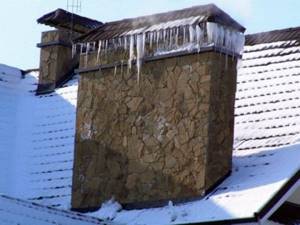
Icy chimney umbrella
The reason is condensation that forms on cold metal upon contact with low-temperature combustion products. This is the temperature of smoke from boiler plants with high efficiency, that is, gas ones. Because of this, it is prohibited to place a cap on a brick chimney pipe. It’s another matter when the boiler is solid fuel, its efficiency varies between 70-80%, and the outlet gas temperature ranges from 150 to 250 ºС. Here you can safely select a nozzle, especially for a brick channel that is destroyed by precipitation. Just remember that it will quickly become covered with black soot.
Note. Pellet boilers running on high-quality fuel can also achieve an efficiency of about 90%, so it’s better not to risk it and use an open nozzle as a canopy on the pipe.
When the issue of boiler installations is clarified, let’s move on to the gas exhaust pipe itself. The easiest way is if it is assembled from a three-layer modular sandwich, then protecting the chimney from rain is not required at all. The ingress of precipitation into the channel even benefits it; the pipe is washed from the inside, and then the water is discharged into the condensate collector. For a gas boiler we choose a nozzle, for a solid fuel boiler - any other nozzle, preferably from a technical point of view - a deflector-vane.
What about a brick pipe? No problem, when it serves a solid fuel boiler, you can choose a cap from any material and any shape you want, according to your means. If the combustion products are removed from the gas boiler through the channel, then the umbrella cannot be placed on the chimney pipe at all, and the constant entry of moisture into the channel destroys the material. Nevertheless, there is a way out of this situation; to be convinced of this, just look at the photo:
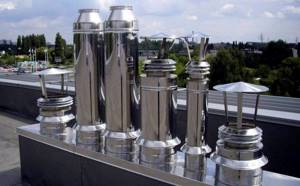
Chimney protection box
Here you can clearly see that the cap is made as a protective box that completely covers the brick base. Since the photo shows a pipe with several channels, some of which are ventilation, the pipes and umbrellas used are different. But nozzles are installed on the chimney ducts in accordance with the standards.
Making a visor
You can make a cap for the chimney pipe with your own hands. The drawings will help you navigate this, but it is important to follow all the parameters specified in it. First of all, you need to determine the external dimensions of the head. The umbrella will be attached here. Following this, you need to sketch a sketch depicting the future structure. To do this correctly, you need to consider the following points:
- the diameter of the product must be 10 cm larger than the dimensions of the pipe so that the edges protrude on all sides up to 50 mm;
- slope angles should vary from 30 to 45 degrees;
- from the chimney cut to the fungus, the minimum height should be 100 mm.
An umbrella is a traditional solution . There are other design options:
- rotating weather vane;
- deflector.
The latter makes it possible to increase traction through wind pressure. Thanks to it, a vacuum is created in the cylindrical body, into which the smoke channel passes. In calm weather, this device retains all its positive qualities. At the same time, it reduces the traction force in the pipe, which results in increased resistance at the exit of combustion products.
A semi-cylindrical weather vane is often popularly called a “sycophant” because it turns with the wind. It is mounted on a special bearing and consists of several components. This is one of the best options, but there are doubts about the reliability of the bearing, and the price of this design is high. It is especially good to install such a model on a round chimney, as it protects the mouth of this device from precipitation and blowing out.
To make a chimney for a canopy with your own hands, it is better to use painted or galvanized metal, the thickness of which is at least 0.5 mm.
Features of the device and its purpose
An important part of the heating system is the chimney, regardless of where the smoke is discharged, be it a stove or a gas boiler. Most often, the chimney is a pipe that has access to the roof. An unclosed chimney very quickly ceases to perform its functions, so it needs protection such as an umbrella for the chimney pipe.
In addition to its protective function, the umbrella has the following purposes:
- Fixes and strengthens brick or stone masonry.
- Prevents destruction of the top part of the pipe.
- Removes condensation and excess moisture.
- Completes the appearance of the pipe and the entire roof.
The main part of the structure is the head, made in free form and with edges downward (read: “Which chimney pipe head to make and how to install it”). Additional structural elements include: a drip tray, a device designed to collect condensate, and fixing elements. The drip cap is not a mandatory element, but its absence leads to a reduction in service life, since the masonry is destroyed under the influence of moisture, and corrosion may appear on the metal parts. For the same reason, it is recommended to install additional protection in the form of a mesh.
Making a Simple Round Umbrella
To perform such work, you need to prepare tools: a drill, metal shears, a hammer and equipment for installing rivets. Once the size of the fungus is determined , work is performed in the following order:
- Screw two self-tapping screws into a wooden plank, maintaining a distance between them equal to the radius of the product + 15 mm. It turns out to be a homemade compass, with which you can make a mark on the metal, marking the central part of the circle. Its outline is also drawn.
- The workpiece is cut with scissors, after which a sector is drawn, the arc length of which is 120 mm. The resulting figure is somewhat reminiscent of a piece of cake.
- The indicated wedge is cut out, and then the outer edges of the figure are aligned with force. Fix them with a vice.
- Drill three holes along the resulting line and connect the ends of the part with screws or rivets. The upper part of the weather vane can be considered ready.
Using steel strips, legs for the fungus and a clamp encircling the pipe are created. They take thin sheets that are bent several times. These parts are similarly secured to the umbrella with rivets.
Gable model
To make a gable weather vane, you need to use a machine called a sheet bender.
Just as in the previous case, first measure the outer surface of the brick chimney. Calculate the pattern and make the corresponding diagram. Next, the cap is assembled using a simple algorithm.
You need to cut the metal and bend it following the dashed lines. The resulting parts must be connected with rivets. The function of rigid racks is performed by ready-made corners made of painted metal , the thickness of which varies from 0.5 to 0.7 mm.
European cap
This model is more designed to prevent the formation of condensation and has a rounded appearance. A chimney of this type can be made independently using a steel sheet and hand-made holders.
How to make a European cap:
- Take a standard metal sheet and carefully bend it around the pipe, or directly along the contour of the chimney.
- They remake the spoons that will hold the cap directly on the pipe. It is best to do this with a special machine or ask a welder you know. You can also make transverse cuts that do not go all the way and carefully bend the strips using pliers.
- These cuts do not have to be transverse. It is permissible to use longitudinal strips if the piece of metal is quite long. A rectangle is cut out along the edges and the tails are left in the center. After this, roll the sheet in the shape of a semicircle and press the tails with a clamp.
- Gently bend the legs.
It is permissible to use a regular chimney pipe clamp to mount such a cap on the pipe.
To make a European cap, all you need is a piece of sheet metal and a grinder disc.
